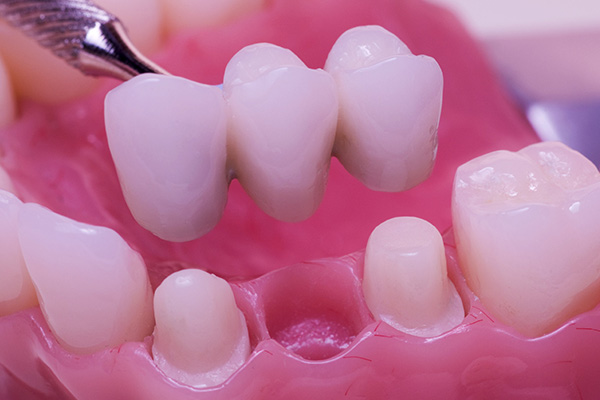Are There Different Types of Dental Bridge?

A dental bridge is a method of replacing one or more lost teeth. People often use the word bridge to indicate a removable tooth replacement option, but dentists have a different opinion. Dental professionals consider bridges as a device that attaches to the teeth permanently and is not removable — at least not by patients. There are different bridge options in terms of design and material, all of which serve the same purpose.
An overview of dental bridges
In every type of dental bridge, the replacement tooth is known as the pontic. The pontic provides tooth functions and attaches to underlying support through retainers or abutments (the structure varies based on the type of dental bridge). Every bridge needs adjacent structures for support, and the pontic lies on top of the gum tissue. Some of the dental bridge options available include the below.
Traditional bridge
The traditional bridge is the most popular type of bridge. It uses dental crowns to cover the teeth on the two sides of the gap. The pontic attaches to the abutment crowns so that the bridge becomes a large unit. The number of pontic depends on the number of missing teeth; together with the retainer crowns, the traditional bridge for a single missing tooth is a three-unit setup.
Traditional bridges should only be used for one or two missing teeth. The strength of the bridge depends on the supporting structures (root and gum) of the abutment teeth.
Cantilever bridge
A cantilever bridge utilizes one abutment tooth on one side of the gap. This means the pontic has only one attachment to a healthy tooth. The strongest tooth near the area gets a dental crown and provides the support needed. This option works better for small teeth that experience minimal chewing forces.
Possible flexing is one of the drawbacks of cantilever bridges. There are rare cases where the cantilever bridge survives several years of use. In most cases, the flexing and chewing forces acceptable by the structure of the cantilever eventually displace the bridge or damage the supporting retainer tooth.
Maryland bridge
This is a variation of the traditional bridge. It uses small wings to hold the pontic, instead of complete dental crowns. The wings lie on the biting surface of the nearby teeth and fixed with dental cement. They are effective options for replacing one front tooth and are highly conservative. They require minimal or zero removal of healthy tooth structure.
Maryland bridges are not suitable for back teeth since the heavy chewing forces can dislodge them. If they are used, it is usually a temporary solution. The drawback of this bridge is the risk of debonding and falling out. Since they are mostly used for front teeth, it can lead to an embarrassing situation.
Implant-supported bridge
An implant-supported bridge is like a regular bridge but uses dental implants for support, instead of adjacent teeth. It is an excellent choice for those who have lost multiple teeth since only two implants can support a bridge with four or more pontics. The main benefit is that they have a lower failure rate and provide better support for chewing.
Ready to get started with a dental bridge?
If you have missing teeth and are considering dental bridge, contact our dental office to schedule a consultation with the dentist.
Request an appointment here: http://www.gentletouchdentalcare.com or call Gentle Touch Dental Care at (718) 924-2387 for an appointment in our Forest Hills office.
Check out what others are saying about our dental services on Yelp: Dental Bridges in Forest Hills, NY.
Related Posts
Are you considering getting a dental bridge to replace a missing tooth? This prosthetic can work wonders, but like with all prosthetics, you might be wondering how you are supposed to maintain it so it lasts forever. Continue reading to find out more.Here are a general dentist's tips about caring for dental bridges. Reviewing this…
Replacing missing teeth preserves the look and function of the smile, and a dental bridge is one of the most versatile ways to do that. Dental bridges are a popular tooth replacement method for numerous reasons. Here is a closer look at the benefits of this restoration and the process for getting one.A dental bridge…
Missing teeth can negatively impact your smile's appearance and health. However, there are treatments out there that can help. Dental bridges are a common dental restoration that can improve oral health and enhance your smile. A dental bridge can be an effective solution if you have lost a tooth due to decay, injury, or other…
A dental bridge is a popular tooth replacement option for those missing one or several teeth. Missing teeth can cause problems that go beyond the aesthetic. Therefore, patients should replace teeth promptly to preserve the health and appearance of their smile. Fortunately, a dental bridge is an effective and natural-looking way to do that.A dental…
